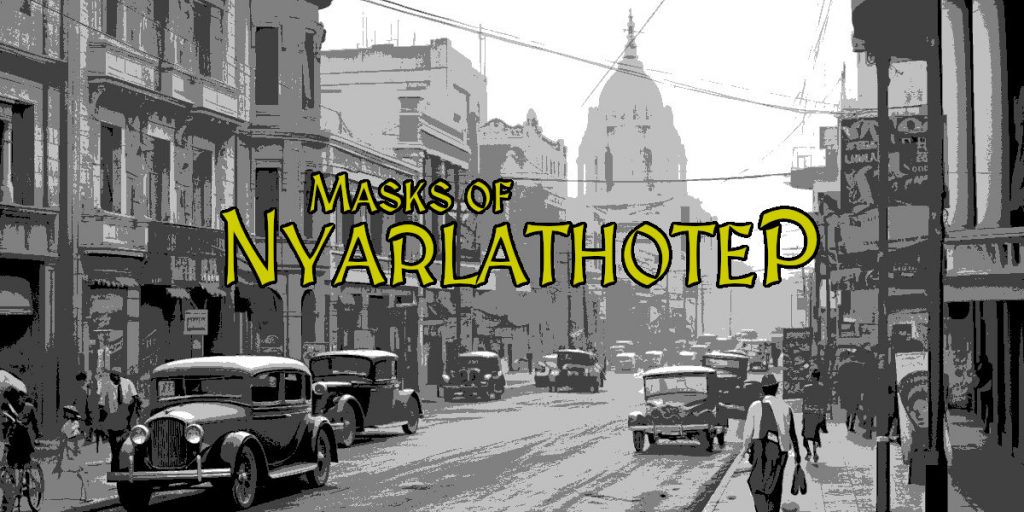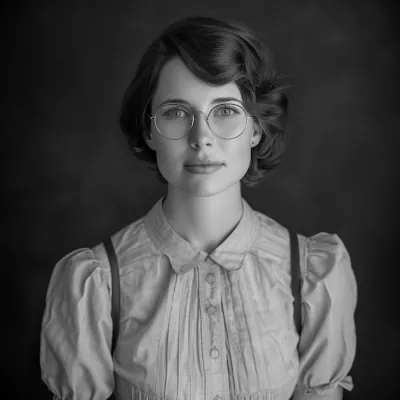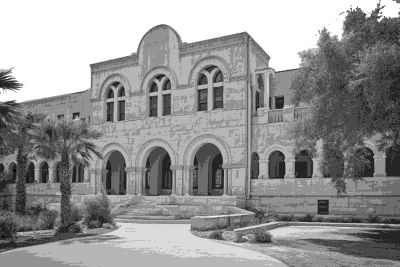Masks of Nyarlathotep

This is the journal of Evelyn Margaret Wooldridge. Born in 1891, I married Robert Wooldridge in 1910. We had two sons, though the first died of the measles in 1914, and my second died of Spanish flu in 1919. I lost Robert at the Battle of Arras in May of 1917. Myself, I worked as a nurse during much of the war in France, so have seen my fair share of the horrors that humanity can bring upon itself.

I come from a good family, and still have the means to support myself and even fund some of my hobbies. Finding professional work is hard, but my donations have got me into the British Museum as a curator, allowing me to pursue my passion for human history.
Recently, word came to us of an expedition in Peru to investigate a lost pyramid up in the mountains. The Museum would much like a chance to obtain some of the artefacts if any are found there, so we have agreed to provide some funding for the expedition. I managed to persuade the Museum to allow me to go along to Peru to meet with the University there and provide research assistance. However, the expectation was that I would not be going on the expedition itself.
Friday, 18th March, 1921

We have arrived in Lima, Peru, where we are staying at the Hotel Maury. We are to meet with the leader of the expedition, a man named Augustus Larkin tonight at 7pm. However, my colleagues seem to have come down with a serious case of food poisoning and are unable to attend. I therefore took it upon myself to attend the meeting alone.
I arrived at the Bar Cordano just before 7pm, and was taken to the table where Augustus Larkin and two other men sat. They were Jessis Hughes, a folklorist from New York, and Luis Mendoza, who was described as assistant to Mr Larkin. Mr Larkin himself looked somewhat gaunt, and was wearing a suit several sizes too large for him.
Shortly after, we are joined by two Americans. One introduced themselves as “Lefty” Buckley, an American police officer, and the other was someone I recognised – Monty. He was briefly a patient of mine during the war, and knew my brother.
Shortly thereafter, another American walked into the bar and is introduced to us as Clayton Baxter. He looked vaguely familiar, though I couldn’t remember where I’d seen him before.
Larkin explained to us that he has come upon information about a lost pyramid in the highlands. He thinks it is Incan, somewhere near Puno. The aim is to obtain artefacts from there in order to prove its existence. Larkin bought some items from an Alpaca farmer who had obtained them from his grandfather. Apparently there were many treasures in the tunnels under the pyramid.
Larkin showed us a couple of the artefacts. One is a pendent which to my eye looked like it was of Tiwanaku origin, dating to maybe 5th century Bolivia. The other looked like an Incan cup from around the 15th century. It seemed unusual that two such artefacts would be found together in the same place.
Larkin thinks that the pyramid is near Lake Titicaca, which would put it on the border of Bolivia. He has trucks and drivers to take us to Puno, a journey which should take about four days. He is planning on leaving from the Hotel Espana at 8am on Monday morning, which would give us the weekend to prepare.
I noticed that Larkin had started to sweat, and that his hands were shaky. I asked him whether he is okay, and he explained that he is suffering from Malaria. He and Mendoza shortly get up and leave. Larkin leaves some cash on the table to pay for the food and drinks.
Talking to Mr Hughes, he explains that he is a folklorist of Cults. He has recently been investigating witch cults in England. As it happens, there is a good book on the subject that I read last year by an American author named Jackson Elias.
Larkin originally tried to hire locals in Puno to investigate the Pyramid, but failed to find anyone interested. Which is probably why he has turned to foreigners. Hughes spoke to the National University of San Marcos. The Professor Nemesio Sanchez there has been trying to join the expedition, but apparently Larkin has been ignoring him.
Professor Sanchez believes there are documents in the University about the location, and Hughes is going there tomorrow. He invited us along to talk to the Professor. He also admitted that his real name is Jackson Elias, the author of many books on cults.
Elias was up in Puno about a fortnight ago. The locals said that Mendosa was a Kharisiri. They are a type of local vampire that suck the fat out of people, a legend that arose at the time of the Conquistadors. Elias thinks that both Larkin and Mendosa are cultists, looking to get any artefacts out for their own reasons. I’m not sure whether to believe him or not. It’s always possible that Elias has similar goals.
It became apparent that several of the men were planning on staying for several more hours drinking, so I made my excuses and got up to leave. Mr Baxter kindly offered to escort me back to the hotel.
Saturday 19th March

The University of San Marcos is the oldest university in the Americas. The Museum of Archaeology was built recently in 1919 though. As agreed, we met there just before 2pm on Saturday.
We were invited in to see Professor Sanches, who was surprised to see all of us as well as Huges (Elias). He offered cigarettes, cakes and coffee, and quickly launched into a rant about the idea of others coming in and stealing artefacts out of his country. Despite Professor Sanches being an expert in this particular field, and having made several attempts to offer his help, Larkin has completely ignored the Professor. Professor Sanches believes that Larkin intends to loot the pyramid and take any artefacts out of the country. Given that my intentions are similar, I decided to remain quiet at this point.
Sanches told us that he has found a document written in the 16th century by a conquistador called Gaspar Figarora. There is a golden artefact with the document as well. He expected that the student who had been given the task of translating it to turn up shortly.
However, the student, Trinidad, was taking her time, so myself, Lefty and Monty offer to go look for her. We were given directions down in the basement where there is a small library. As we entered, Lefty suddenly ran forward to the end of the aisle of books, where, I then noticed, there was a female foot sticking out from behind the shelf. Lefty suddenly seemed to stop in shock, and a strange hissing sound came from around the corner.
Lefty stumbled back, and Luis Mendosa lurched into view. However, what I saw I’m not sure. He seemed to have some strange mask on, which gave the impression of a large mouth and too many teeth. There was screaming and the sound of gun fire. The screaming turned out to be me, and it took some moments for me to gather my composure. I had seen things that humans can do, but for a moment what I saw I imagined to be quite inhuman. I’m sure though that it was just my overactive imagination, but I still see the horror when I close my eyes.
As I recovered my wits, I saw Mendosa laying on the floor. He twitched, and Lefty and Monty started unloading their guns into him again. However, somehow Mendosa refused to stop moving. Finally Lefty unloaded a shotgun into his head. He, it, turned to look at him, his mask in bloody tatters but I imagined it to be still pulling itself together. Finally Lefty decapitated him with a large knife, and the body slumped to the floor.
Gathering my courage, I checked on the other body. It was a young woman, probably Trinidad. Her upper clothes had been torn and there was signs of a wound on her chest. She was still alive though, and conscious. I helped her up and provided some first aid. She looked thin, but that may have been her natural state.
Recovering from the shock, she gathered up some papers and a large piece of gold which had fallen to the floor. She and I took it upstairs to Professor Sanches whilst my two colleagues cleaned up downstairs. After being informed of the attack, Sanches called the local police, and brandy is produced for those of us requiring it.
When the police arrive they head downstairs to talk to Lefty and Monty, but are satisfied that Mendosa had attacked the young woman and was killed whilst defending her.
Upstairs, we are shown the translated document, which seems to detail the confession of a Conquistador named Figueroa, who had investigated the Pyramid back in the 16th century. He and his companions found much gold beneath the pyramid, and took some of it for themselves. However, a sickness befell his companions soon after. They became gaunt and death-like, complaining of a great hunger. Figueroa fled when his companions tried to eat him. One of the companions was named de Mendoza, and Figueroa shot him in the head during his escape.
Figueroa said that he could still hear the voices of his companions crying out in hunger, as well as another voice, ancient and seductive, which called to him promising eternal life. Shortly after providing his final confession, Figueroa died.
It seems that Larkin may not be the most trustworthy of people to work with, so what we do next I’m not yet sure. I know the British Museum would very much like to continue the expedition though, and see what could be found near the Pyramid of Lake Titicaca.
This was our first return to face to face gaming since before lock down, and should be the start of a long Call of Cthulhu campaign. Chaosium and the HP Lovecraft Historical Society have really gone to town in terms of providing support for this campaign, with a huge collection of impressive player handouts including maps, photos, newspaper clippings and even passports for all the characters.

Most of our first session was character generation (including using Midjourney so we had suitable character photos to put in our passports). We are using the Pulp Cthulhu rules, which should improve the survival chances of our group. Even so, for my own character, Evelyn, I’ve provided her with a number of family members who could come ‘looking for her’ in case I need a replacement character. She’s already failed one sanity check.
Evelyn has taken the Librarian profession, making her the knowledgeable one in the party. She also served as a nurse during the Great War, so has first aid and medicine skills as well, which have already come in useful.
This is planned to be a monthly campaign, and by the end of it I hope to be able to spell Nyarlathotep without having to look it up (though n10p might end up being a suitable short hand). Our first session was a lot of fun, and it was really good to get people back together around a real table. I’m looking forward to the next session.